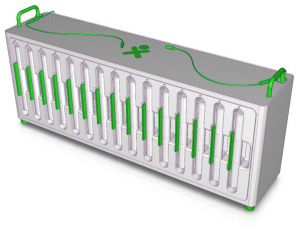Multi channel battery charger
This page is monitored by the OLPC team.
| NOTE: The contents of this page are not set in stone, and are subject to change! This page is a draft in active flux ... |
Contents
Multi Channel Battery Charger
See Product News for product availability.
Key Specifications
- 15 batteries per unit.
- Charge batteries in 2 hours
- AC (120/240V) and DC operation
- Operate at 50 degrees Centigrade ambient temperature
Electrical Input Requirements
- AC Power 100V-230V. 300W
- DC 12V-30V. 150W
Electrical Misc
- The CPU is an Atmel At91SAM7x family part.
Exterior devices
- AC In: IEC for 120 to 220VAC
- DC In: 12VDC to 30VDC 2 Pin connect that mates with whats on the GP solar blanket.
- DB9 for RS-232??
- USB B connector (Its a USB device)
- Two indicator lights per battery channel
- Red Led and Green Led. Use the same setup as in the laptop. Red, Green, and Yellow both are enabled.
switch batteries.
- Future RJ45 10/100 ethernet connection
Software
- will be updated soon
Mechanical
- Density. Getting as many batteries as possible in as small a footprint is a goal.
- Physical Safety. Its got to be stable and hold lots of heavy batteries but not be able to fall over on top of a child. Who might be trying to climb on it to get his battery.
- Stackable. More vertical space is available than floor sq footage so an idea was to make them stackable. But see above point.
- Heat dissipation. Each battery needs 15W worst case and most of that power will be dissipated into the batery. I expect the electronics/battery to dissipate less than 1W/battery. PSU at 300W @ 85% efficiency is 45W.
- Enclosure. Metal. Except perhaps for some plastic for the battery holder. Having metal available to heatsink to should help in keeping the electronics from burning up in hot countries.
Datasheets
- File:At91sam7x128 256 pc.pdf Atmel CPU
- File:DS2756.pdf DS2756
- 30A connector
